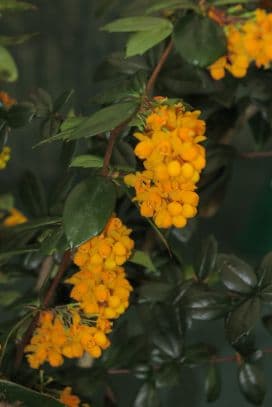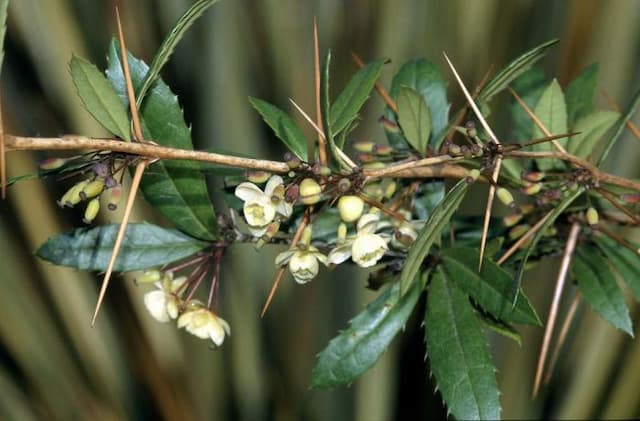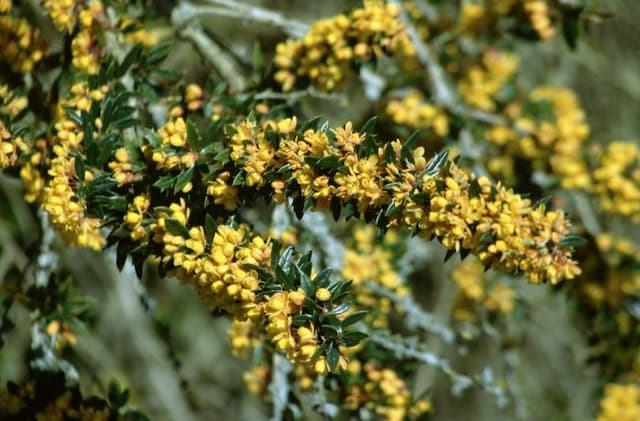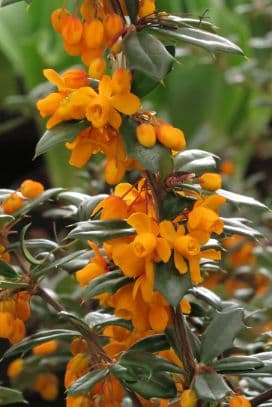Japanese barberry Berberis thunbergii f. atropurpurea 'Bagatelle'

ABOUT
The plant commonly known as Japanese barberry 'Bagatelle' is a compact and decorative shrub, characterized by its striking foliage and thorny branches. The plant is noted for its leaves that exhibit a deep, reddish-purple hue which adds rich color to gardens throughout the growing season. The leaves are small, oval-shaped, and grow in an alternate pattern along the stems, providing a dense, layered texture. During the spring, the Japanese barberry 'Bagatelle' produces small, yellow flowers that dangle in clusters along the length of the stems, contrasting elegantly against the dark foliage. By autumn, these blossoms develop into small, bright red berries that are attractive to birds and add a splash of color to the fall landscape. Thorns are present along the branches, offering a distinct look but also requiring care when handling or pruning the shrub. These thorns contribute to the plant's defensive traits, deterring herbivores from browsing. Overall, the Japanese barberry 'Bagatelle' is appreciated for its year-round visual interest, created by its colorful leaves, flowers, and berries, which stand out in a variety of landscaping themes.
About this plant
 Names
NamesFamily
Berberidaceae
Synonyms
Japanese Barberry, Red Barberry, Purple-leaf Japanese Barberry, Dwarf Purple Barberry, Bagatelle Barberry
Common names
Berberis thunbergii var. atropurpurea 'Bagatelle'.
 Characteristics
CharacteristicsLife cycle
Perennials
Foliage type
Deciduous
Color of leaves
Red
Flower color
Yellow
Height
2 feet (0.6 meters)
Spread
2 feet (0.6 meters)
Plant type
Shrub
Hardiness zones
4
Native area
Asia
Benefits
 General Benefits
General Benefits- Compact Growth: Ideal for small gardens or limited spaces due to its dwarf habit.
- Ornamental Appeal: Offers attractive deep purple foliage that adds color contrast in the landscape.
- Low Maintenance: Requires minimal care once established, suitable for novice gardeners.
- Seasonal Interest: Provides year-round visual interest with foliage, yellow flowers in the spring, and red berries in the fall.
- Drought Tolerant: Once established, it can withstand periods of drought, reducing the need for frequent watering.
- Deer Resistance: Typically resistant to browsing by deer, making it suitable for gardens in areas with wildlife.
- Erosion Control: Can be used on slopes and banks to help prevent soil erosion.
- Hedge & Border Use: Ideal for creating low hedges or borders due to its dense, compact growth habit.
- Winter Hardy: Capable of surviving in colder climates, providing landscape interest even in winter.
 Medical Properties
Medical Properties- This plant is not used for medical purposes.
 Air-purifying Qualities
Air-purifying QualitiesThis plant is not specifically known for air purifying qualities.
 Other Uses
Other Uses- Photography: Japanese barberry 'Bagatelle' provides a dramatic, dark foliage background for plant photography, enhancing the contrast and highlighting the colors of other garden plants.
- Hedging for Miniature Gardens: Its compact growth habit makes it ideal for creating low, formal hedges in fairy or miniature gardens.
- Seasonal Decorations: Branches of Japanese barberry 'Bagatelle' can be snipped and used in fall or winter floral arrangements due to their rich, purple-red foliage and bright red berries.
- Wildlife Shelter: Although non-native, the dense, thorny branches can provide a safe nesting space for small birds in the garden.
- Culinary Garnish: While not commonly known, its berries can be used as a garnish for certain dishes, providing a splash of color (Note: berries can be toxic if ingested in large quantities).
- Color Theory in Art: Art teachers might use the foliage as a real-life example to teach color theory, showcasing the plant’s complementary contrast between the purple leaves and yellow autumn foliage.
- Dye Production: Historically, some species of barberry have been used to produce a yellow dye, with potential for use in natural fabric dyeing.
- Bonsai: More adventurous gardeners might use this dwarf variety to create bonsai projects due to its manageable size and visually appealing foliage.
- Tactile Experience: Planting Japanese barberry 'Bagatelle' along a sensory garden path provides a different texture for visually impaired visitors to experience.
- Landscape Art: The plant can be used in landscape art to provide a contrast in textures or colors, especially because it holds its leaf color well throughout the seasons.
Interesting Facts
 Feng Shui
Feng ShuiThe Japanese Barberry is not used in Feng Shui practice.
 Zodiac Sign Compitability
Zodiac Sign CompitabilityThe Japanese Barberry is not used in astrology practice.
 Plant Symbolism
Plant Symbolism- Protection: Berberis thunbergii, commonly known as Japanese barberry, is often associated with protection due to its thorny branches, which can create an impenetrable barrier against intruders or negative forces.
- Adaptability: With the ability to thrive in various soil types and climates, Japanese barberry symbolizes adaptability and resilience in different life circumstances.
- Bitterness: The berries of the Japanese barberry are tart, which can symbolize bitterness or sour experiences in life.
- Purity: In some cultures, the bright red color of the berries is associated with purity and cleansing.
 Water
WaterThe Japanese Barberry 'Bagatelle' should be watered deeply once a week, ensuring the soil is moist but not waterlogged. During the growing season and in the absence of rainfall, increase watering frequency to twice a week. For each watering session, provide about 1 gallon of water for each plant to ensure the root zone is adequately saturated. During the winter months or cool seasons, reduce watering as the plant's water requirements decrease. Always check the soil moisture before watering to avoid overwatering, and during hot, dry spells, additional water may be necessary.
 Light
LightThe Japanese Barberry 'Bagatelle' performs best in full sun to partial shade. For optimal growth and foliage color, situate the plant in a spot that receives at least 4 to 6 hours of direct sunlight daily. Locations that offer morning sun with afternoon shade are ideal to protect the leaves from potential scorching in regions with intense midday sun.
 Temperature
TemperatureThe Japanese Barberry 'Bagatelle' thrives in a range of temperature conditions but is best suited to environments where the temperature seldom drops below -30 degrees Fahrenheit (-34 degrees Celsius). The ideal growing temperature for this plant is between 50 and 70 degrees Fahrenheit. It can survive up to about 100 degrees Fahrenheit without significant stress, provided it is sufficiently watered.
 Pruning
PruningPrune Japanese Barberry 'Bagatelle' to shape it, remove any dead or diseased branches, and promote bushier growth. The best time to prune is late winter to early spring before new growth starts. Thinning the interior branches every few years will help to maintain the plant's health by increasing air circulation. Light pruning can be done throughout the growing season to keep the plant tidy.
 Cleaning
CleaningAs needed
 Soil
SoilFor Japanese Barberry 'Bagatelle', the best soil mix is well-drained with some organic matter. A mix of loam, peat moss, and sharp sand can provide the right structure. The pH should be slightly acidic to neutral, ranging between 5.5 and 7.5 for optimal growth.
 Repotting
RepottingJapanese Barberry 'Bagatelle' does not require frequent repotting. It should be repotted every 2 to 3 years to refresh the soil and accommodate the growth of the plant.
 Humidity & Misting
Humidity & MistingJapanese Barberry 'Bagatelle' is tolerant of a wide range of humidity levels and does not have specific humidity requirements. Outdoor average ambient humidity is generally suitable for this plant.
 Suitable locations
Suitable locationsIndoor
Provide bright light, avoid overwatering, and ensure good air flow.
Outdoor
Plant in full sun to partial shade and well-draining soil.
Hardiness zone
4-8 USDA
 Life cycle
Life cycleJapanese Barberry 'Bagatelle' starts its life as a seed, often spread by birds that eat the berries and disperse the seeds. Upon germinating, the seedling emerges and begins to develop its distinctive purplish-red leaves if conditions are optimal, with full sunlight to partial shade and well-draining soil. As it reaches juvenile stage, the plant grows into a compact, mound-shaped shrub with spiny branches, and by maturity, it can reach 1 to 2 feet in height and width. Throughout spring, it produces small, inconspicuous yellow flowers, which then develop into bright red berries by late summer or fall, attracting wildlife and facilitating seed dispersal. The shrub has a perennial life cycle and will enter dormancy during the winter months, losing its leaves and waiting for spring to resume growth. Over time, the 'Bagatelle' may spread slowly to form dense thickets if not pruned or controlled.
 Propogation
PropogationPropogation time
Early spring
The popular method of propagation for Japanese barberry 'Bagatelle' is through softwood cuttings. This process usually takes place in late spring to early summer. Collect cuttings that are about 4 to 6 inches (10 to 15 cm) in length from new growth that is just beginning to harden but is still flexible. Remove the lower leaves and dip the cut end in a rooting hormone to enhance root development. Plant the cuttings in a mixture of peat and perlite or a well-draining potting soil, keeping the humidity high and the soil consistently moist. With proper care, roots should develop in a few weeks, after which the new plants can gradually acclimate to less controlled conditions.







![Japanese barberry [Bonanza Gold]](/_next/image?url=https%3A%2F%2Fplants-admin.emdemapps.com%2Fimages%2Fplants%2F%2Fimages%2F604b5385e413f.png&w=640&q=75)

